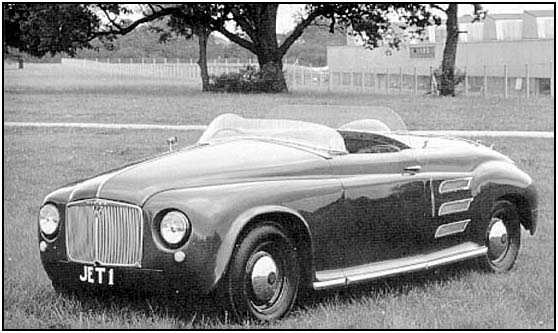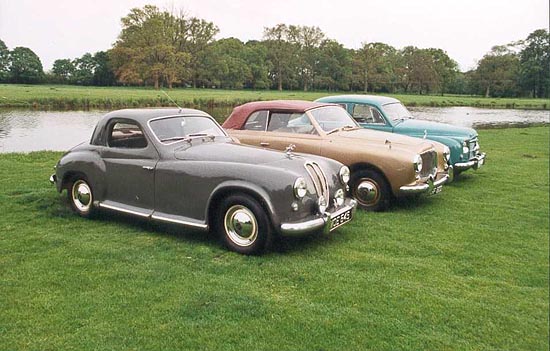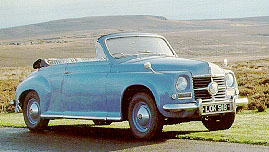|
Throughout the 15 years that the Rover P4 was made, there have been several variations, quite apart from the mainstream production models produced by the works in Solihull. Some were experimental prototypes by the Rover design group, others (for example the Marauder) were more-or-less sanctioned by the Rover Company, and some, of course, were the result of ingenuity or otherwise on the part of individual Rover owners. The most famous variation must surely be JET 1, the first car to be powered by a gas turbine engine. Built in 1950, the experimental turbine car developed over 200 HP. On a test run in 1952, it attained a top speed of over 152 MPH! As a significant milestone in motoring history, JET1 is now preserved in the Science Museum, London. 
In the photo below, two other interesting variants can be seen, along with a very early production Rover 75. On the left is the unique Marauder fixed-head coupe, and behind it is a Rover 75 drop-head with body by Farina of Turin. All three cars are owned by George Hamill of Canterbury, who very kindly supplied this photograph.
The Marauder car was the brainchild of three Rover engineers, Peter Wilks, Spen King, and George Mackie. The intent was to produce a sports car based on the Rover P4 chassis and mechanicals with a two-seater sporting body. Wilks, Mackie & Co. was formed in 1950 to build the cars, with the Rover Company agreeing to supply components for an initial run of 21 vehicles. Bodies were first supplied by Richard Mead's of Birmingham and later by Abbey Panels of Coventry. Most were drop-head coupes, although the fixed-head coupe shown in the photo was built by Meads to special order. In all, fifteen Marauders had been produced before the Marauder Car Company went into voluntary liquidation in 1952. The Farina-bodied prototype arose from a desire on the part of Rover management to explore ways of expanding the P4 range. In 1952, Pininfarina of Turin was commissioned to create an alternative body style, and two prototypes were duly delivered -- a drop-head and a fixed-head version. The drop-head was exhibited at the 1953 Earl's Court Motor Show where it attracted a great deal of interest. However, the estimated costs of putting the car into production were considered to be too high, and the project was discontinued. Nevertheless, some of the car's styling features were not lost, re-appearing in the Rover 3-litre P5 of 1958.
|
|
Please use your browser's "Back" button to |
|
|

 Rover themselves experimented with a convertible version of the P4 and in 1950 and 1951 built a few prototypes on Rover 75 chassis.
These cars had coachwork by Tickfords of Newport Pagnell.
The particular example shown here (also now owned by George Hamill of Canterbury) may be the only one to survive. Restoration started in 1985, and the car was featured in the September 1992 number of "Classic Cars" magazine.
Rover themselves experimented with a convertible version of the P4 and in 1950 and 1951 built a few prototypes on Rover 75 chassis.
These cars had coachwork by Tickfords of Newport Pagnell.
The particular example shown here (also now owned by George Hamill of Canterbury) may be the only one to survive. Restoration started in 1985, and the car was featured in the September 1992 number of "Classic Cars" magazine. 